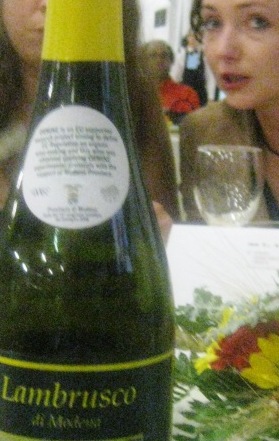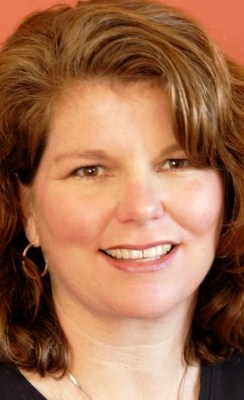
Dr. Alan Greene, Stanford Professor and author of Raising Baby Green, addressing the 2008 Organic World Congress on epidemiological studies relating to bovine hormones. "We have it backwards," he says. "We should find out the adverse effects of additives before we introduce them into the food chain."
I am privileged to attend the triennial Organic World Congress in Modena, Italy in late June. This is the world's largest gathering of organic agriculture's standard-setters, strategists and thinkers, with 1,500 participants sharing hundreds of presentations and research papers. I am Huff Post/Green's accredited journalist and this is the first of several reports.
Our host city is Modena (pronounced MAWD-enna), Italy - a small but important place where the green pace is set by bicycles outnumbering cars five to one downtown. It has 175,000 residents in a province of about 800,000 and a region (Emelia-Romagna, centered on Bologna and taking in most of the Po Valley) of about 4 million.
From an expo point of view, the Organic World Congress is small potatoes. The BioFach expo in Nuremberg, Germany, is huge. In the United States, the Natural Products West Expo in Los Angeles has 3,400 exhibitors this year and was no slouch with 52,000 registrants, an increase of 11 percent over last year. The All Things Organic show in Chicago attracts similar numbers.
What impresses me about the IFOAM conference is the depth of representation from the academic, NGO and government community, with 400 oral presentations and 350 poster presentations. My takeaway will be an armload of theories and evidence, samples of exquisite food using organic products and conversations with hundreds of people who are truly thinking at the edge about the future of a world where fertilizers and pesticides will rise in cost and change the economics of farming. I will be posting sampling from all areas of the conferences, including practical recipes and a wide range of personal profiles.

From Lambrusco Grapes to Balsamic Vinegar. It's amazing how long the balsamic vinaigrette franchise has been kept in Modena. The local producers start with a good grape, the Lambrusco, which is also made separately into a fine wine. The local Este family has records of "balsamic" in connection with vinegar as long ago as 1747, and in 1046 that the local vinegar was sought by Henry II on a visit to the area.
Local balsamic vinegar producers such as the Barbieri family press their Lambrusco (or Trebbiano) grapes softly and then cook the result in steel vats before fermentation. The fermentation process takes place over many years in a series of barrels of different kinds of flavorful woods such as cherry, chestnut, juniper, mulberry that have been themselves been first aged for a year. Certified bottles of aceto balsamico must be aged for at least 12 years and if certified will include the words "Tradizionale di Modena" on the label. Vinegar aged more than 25 years will include the additional two words "Extra-Vecchio" (extra-old). Common sizes of bottles are 1/10 liter and 1/4 liter and certified bottles are not cheap!
Recipe: Strawberries, sugar and balsamic vinegar. Wash a pound of strawberries well, cut them into vertical slices. Cover with 3 ounces of sugar and put in the refrigerator for an hour. Just before serving add Extra-Old Balsamic Vinegar to taste. Serves 3 or 4.

Organic Cotton - Meet Jill Dumain. She is in the next row in the conference bus from Modena to visit the green winemaking Castle at Levizzano Rangone. She works for Patagonia and also serves as Chair of the Board of the Organic Exchange, www.organicexchange.org. The Exchange is a group of cotton growers, organic-yarn spinners like Topkapi, textile weavers like Anvil Knitwear (whose CEO just won the Ernst & Young Entrepreneurship Award in New York City), and retail buyers like Marks & Spencer, Otto and Patagonia. The Exchange, she sums up, " promotes organic agriculture and transparency in the clothing production chain." Her employer has sought to further transparency in its own production by posting ten supply-chain stories at www.footprintchronicles.com.
Jill's presence at the conference is a reminder that organic agriculture is not just about food. An entire mini-conference is under way in Parma on organic textiles. Figures presented at the conference impressed me with the risks to workers and the local environment of chemical use in the cotton industry. Five pesticides commonly used in cotton production are known carcinogens. Pesticide poisoning kills an estimated 20,000 people a year in the world, and causes three million injuries, nearly half attributable to cotton pesticide use. Conventional agriculture is held responsible for 70 percent of pollution problems in U.S. rivers and stream.
The good news is that consumers appear to value organic textiles. I ran across a poll of British Columbia residents that reports 58 percent of consumers more likely to shop at clothing retailers offering eco-friendly clothing - i.e., made with natural fibers (organic cotton, silk, wool, hemp, etc) grown without pesticides within sustainable farming environments. Interest in eco-friendly clothing is strongest among the youngest consumers, aged 18-39. Which makes you think because some of these important opinion-makers are younger than Extra-Vecchio Aceto Balsamico Tradizionale di Modena.
Next Report: Green Wine-Making